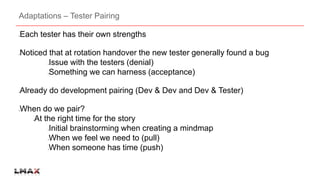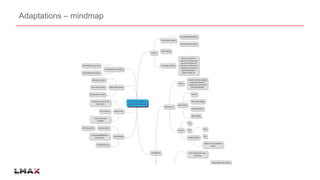Testing within an Agile Environment - Beyza Sakir and Chris Gollop
- 1. Testing within an agile environment Chris Gollop & Beyza Sakir
- 2. Overview History Changing Testing Concerns Adaptations Future Conclusion Further Reading
- 3. History – what we do Release every 2 weeks Trade $billions/day Average 0.4ms execution time for MTF members 10,000 orders second 1 tester per 5-6 developers Very low rate of production issues
- 4. History - company Conceived as an Agile company Agile has matured but we’re still adapting Agile testing: Acceptance Tests Integration Tests Exploratory Testing
- 5. History - company •This has allowed us to experiment and adapt: •Time freed up •Quick feedback on changes •Historic data available to analyse
- 6. History – test team 4 test specialists with different strengths complement each other as a 'team‘ Rotate through all teams •No Test Manager •Part of development team though test interests have a separate iteration meeting •Testing is responsibility of everyone
- 7. History – team structure l Team One Team Two Team Three Development Specialists Business Specialists Test Specialists
- 8. History - innovate Keep changing, even if something appears to work there may be something better “If I had asked people what they wanted, they would have said faster horses. I gave them a car” (Henry Ford)
- 9. History – measure and feedback Measure To know if it is effective Many monitoring and measuring tools Feedback Tying feedback to ideas Quicker this is the faster you can confidently adapt Can be numerical or social
- 10. Changing Testing Concerns Over Time Traditional Testing Maturity Models start at “ad-hoc” and move through structured testing before finishing at “Continuous Improvement” Some of our test concerns (over time) Decrease Manual Testing & increase automated Acceptance Tests Performance DSL Speed of Feedback Increasing number of Edge Cases as system becomes more complex
- 11. Changing Testing Concerns Over Time 10,000 Behavioural Tests 8,700 Acceptance Tests (UI, API) 1,300 Integration Tests (subsets of services using internal interfaces) Acceptance Test would test a rejection Integration Tests would test the different rejection types
- 12. Changing Testing Concerns Over Time Was right at the time as needed Acceptance Tests to get good coverage quickly, trade-off is they are slower to run repeatedly. Focus is now quicker feedback.
- 13. Adaptations – Fitness Landscape
- 14. Adaptations – Fitness Landscape Each square is similar to it's neighbour Higher it is the better the solution – valleys are bad, mountaintops are good You don't fully know where you are on the landscape You feel your way by trying out new ideas and recognising failure You may be half-way up the mountain rather than at the top And the mountains move! Some peaks move faster than others: Google v McDonalds Evolution isn't just biological it's everywhere
- 15. Adaptations – Palchinsky Principles Peter Palchinsky was a Russian engineer who advised on (against) Lenin Dam and Magnitogorsk – large projects which essentially failed due to being too big and unable to adapt. Palchinsky Principles are shaped to encourage stronger innovation, better leadership and more effective policies: Variation - seek out new ideas and try new ideas Survivability - when trying something new do it on a scale where failure is survivable Selection - seek out feedback and learn from mistakes as you go along, avoid an instinctive reaction of denial
- 16. Adaptations – Recognise failure quickly Being able to recognize a failure means you can re-cast it into something more likely to succeed. Accept something is failing, don’t deny or ignore it. "Hard to see what changes would improve current process when they’re currently sweeping all problems under the ‘our context’ rug." (Anthony Green) The essential first step is being willing to fail.
- 17. Adaptations - Google v Apple Both considered as innovative companies. Apple innovates in things that are core to its business Google innovates on things that indirectly contribute to its business Apple releases products that are polished and well-scoped Google releases many different products (Buzz, Wave, Docs, AppEngine) early in their development and lets the community develop and adapt them. Apple create new mountains on the fitness landscape Google is surfing along on, or near, the moving fitness landscape mountain-top by adapting its strategy and offerings.
- 18. Adaptations – a brief history of what we have tried
- 19. Adaptations – what worked Production Data Testing in Live Big Feedback Remove Intermittent Tests Tester Pairing
- 20. Adaptations – Sanitised Production Data Raw data (database) Patterns of use Data profile patterns Migration (automated) Real world data Larger than we can create Many edge cases Try and reincorporate into our Acceptance Tests Performance Staging Progression in what and how we use the data
- 21. Adaptations – Testing in Live Uses same hardware and code as it is just an isolated venue Runs a subset of the Acceptance Tests When we expanded our Exchange by adding a multi-tenanted concept known as a venue we took advantage for testing Verifies that the various components of the exchange are hooked up and configured correctly and that the deployment process worked correctly Runs automatically throughout the day as one of our monitoring systems
- 22. Adaptations – Big Feedback
- 23. Adaptations – Big Feedback Important CI pipeline builds at the top Red (failed) items rise to the top Continuously and easily expanded Useful features survive Failure ownership/failures at a glance - AutoTrish Intermittent tests - Magic Eight Ball Auto Embargo Performance metrics Build sheriff to keep check-in embargo
- 24. Adaptations – Intermittent Tests Tests that can fail even if feature is working Now have <1 intermittent tests per run (out of 8,200) Each about 1 test run in 20 Hides genuine failures Have previously missed a release as couldn't tell if genuine Can result from Asynchronous messaging Tests changing global settings/lack of isolation End of day transitions Date/time
- 25. Adaptations – Intermittent Tests anon anon
- 26. Adaptations – Intermittent Tests All Failures run twice Fail twice = failure Fail once, pass once = intermittent Accepted as something we need to deal with Work to remove DSL improvement Fix a genuine issue (race condition) End of iteration is given over to removing intermittency Build Sheriff also works on this
- 27. Adaptations – Intermittent Tests
- 28. Adaptations – Intermittent Tests
- 29. Adaptations – Tester Pairing Each tester has their own strengths Noticed that at rotation handover the new tester generally found a bug Issue with the testers (denial) Something we can harness (acceptance) Already do development pairing (Dev & Dev and Dev & Tester) When do we pair? At the right time for the story Initial brainstorming when creating a mindmap When we feel we need to (pull) When someone has time (push)
- 31. Adaptations – what didn't work Not many absolute failures Although many reasons it can fail Even if something fails you learn something Natural selection will continue You can't stay still, unless you are improving you are losing ground as others will innovate or adapt
- 32. Adaptations – facts Of the top 25 industrial corporations in the United States in 1900, only two remained on that list at the start of the 1960s. And of the top 25 companies on the Fortune 500 in 1961, only six remain there today (IBM) Average life expectancy of a Fortune 500 company has declined from around 75 years half a century ago to less than 15 years today, and heading towards 5 years (Deloitte)
- 33. Future Expanding the way we test Speed up feedback Increasing integration test coverage Pushing UI to API – testing at the right layer Change AT run order Improving feedback/communication Test team standups Documentation What is just enough How to get people up to speed in a complex system
- 34. Future Is about the people Team make-up is varied and we recruit to keep it this way “’Testing is a strictly formal process that by its nature should not vary’ - this is a typical belief by people who know nothing about testing.” (James Bach).
- 35. Conclusion Need to experiment and adapt to stay ahead Even if something works it does not mean there isn't something better Make changes on a scale where failure can be survived Do not be afraid of failure but know how to recognise it quickly
- 36. Further Reading •Tim Harford •Richard Wiseman •Malcolm Gladwell •Daniel Kahneman •Dan Ariely •Richard Thaler •LMAX Staff blogs - http://blogs.lmax.com/staff-blogs/




































